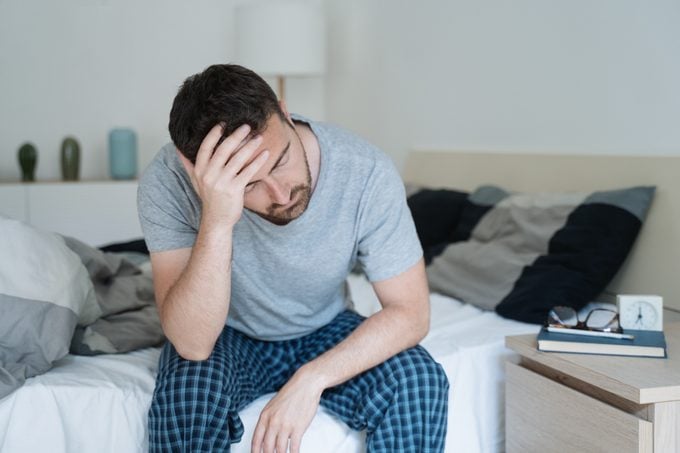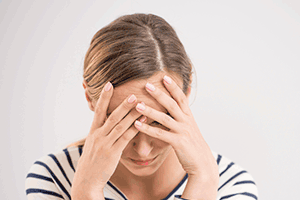What Is a Migraine Hangover?
Updated: Nov. 22, 2021
A migraine hangover feels similar to how you do after spending a night on a bender, but without the prior fun. Here's what you need to know about migraine hangover.
These days nearly all of us know someone who experiences migraines, or experience them ourselves. Migraine is the third most common illness globally and some 12 percent of people living in the United States experience it, according to the Migraine Research Foundation.
And having a migraine is not the same as having a regular headache. In many cases, migraines are disabling when they occur, and migraine is the sixth most common disabling condition in the world. Every 10 seconds or so, someone in the United States seeks emergency care for migraine head pain.
While most people think of the headache or aura stages of migraine, for some people the stage after the headache period resolves, or postdrome stage, is just as disabling. Even if it’s not disabling, the postdrome stage generally causes people to feel unwell and exhausted, which is why some people call this stage a migraine hangover or the hangover migraine stage.
But what is a migraine hangover, and is there anything you can do to treat or prevent it? Here’s what leading headache specialists want you to know about migraine hangover.
What is migraine?
Migraine is not simply another type of headache.
“We think of migraine as a chronic neurological disease rather than just a headache,” says A. Laine Green, MD, at Dartmouth-Hitchcock Medical Center in Lebanon, New Hampshire.
“Migraine effects both the central and peripheral nervous systems,” he explains. “It’s a disease of how our body processes sensory information.” He says a lot of the manifestations of migraine involve pain, but it can also affect how people think and act.
Experts say migraine is often disabling and can greatly affect someone’s everyday life. Dr. Laine says researchers think migraine has a strong genetic component, which tends to make some more predisposed to developing migraine.
“I often think about migraine as a threshold,” he explains. “Most people under the right set of circumstances could have a migraine, but people with a genetic predisposition are more prone to having them, or it takes less to push them past this threshold and develop migraine.”
What are the stages of migraine?
In general terms, there are four migraine stages, though not everyone has to experience every stage of migraine or experience the same stages every time they get migraine.
“There are four classic stages of migraine,” says Dr. Laine.
“There is the prodrome phase that can happen for hours to days before the actual headache. Some people also experience an aura stage, which is traditionally after the prodrome stage and before the headache phase, though it can overlap with both of these stages a bit, then there’s the postdrome stage, or as some people call it, the hangover phase.”
Experts say symptoms during the aura and headache stages are often more pronounced than the other stages and the stages most people associate with migraine. Symptoms associated with the prodrome stage can be vague and linked with other common conditions.
“The second phase, aura, occurs in about one-third of people with migraine, though it may not happen with every migraine attack,” says Lauren R. Natbony, MD, a headache specialist and assistant clinical professor of neurology at the Icahn School of Medicine at Mount Sinai in New York City and committee member of the American Headache Society (AHS).
“The aura phase typically lasts from five to 60 minutes and is followed by headache in most people. Aura is most commonly visual and patients report seeing spots, stars, flashing lights, zigzag lines, etc.,” Dr. Natbony says.
Other common symptoms during the aura stage of migraine include sensory loss, such as numbness or tingling on one side of the body, and slurred speech.
Dr. Natbony says the headache phase of migraine typically presents as pounding or pulsating head pain on one or both sides of the head that lasts between four and 72 hours. In addition to pain, she adds, other symptoms that may occur during the headache phase include:
- nausea and vomiting
- sensitivity to light, sound and smell
- neck pain
- blurry vision

What is a migraine hangover?
According to experts and leading migraine and headache organizations, what many people call a migraine hangover is actually the fourth stage of migraine, known as the postdrome stage. Dr. Laine says he thinks people refer to this stage as their migraine hangover because many of the symptoms people experience are similar to those that can occur after a night of excessive drinking.
“Postdrome is the last phase [of migraine] and occurs in about 80 percent of those with migraine,” Dr. Natbony says. “It is the after-effects of a migraine headache and can include fatigue, trouble concentrating, mood changes, etc.”
She says postdrome can be extremely debilitating and can last for 24 to 48 hours after head pain has resolved.
Symptoms of a migraine hangover
Dr. Laine and Dr. Natbony say the symptoms associated with the postdrome stage or migraine hangover stage can mimic the symptoms someone experiences in the prodrome stage—or they can be the opposite.
“Fatigue is likely the most common symptom people complain of during this stage, but there can also be alterations in mood, either up or down, ” Dr. Laine says. “Some people even feel euphoric once the pain of the headache phase has ended.” He adds that attention and concentration problems are also very common during the migraine hangover stage.
Other symptoms that may occur during the postdrome stage that overlap with the prodrome stage include:
- irritability
- increased need to urinate
- food craving or aversions
- sensitivity to sounds, smells, touch, and light
- difficulty reading or speaking
- nausea
- trouble sleeping
- muscle aches or stiffness
- trouble with comprehension
- dizziness
- dehydration
- tender scalp
Dr. Laine says all of these symptoms essentially cause someone to feel physically and mentally wiped out. All in all, migraine hangover can be just as disabling as the headache or aura stage of migraine, though for some people symptoms during this period are less severe or even mild.
Experts say it’s important to remember that even though the headache stage of migraine may be over, during a migraine hangover you are still experiencing migraine.
How to treat migraine hangover
Dr. Laine says it can be hard to treat migraine hangover because the migraine has progressed so far by this point. He adds most treatments are designed to prevent or reduce the headache stage of migraine and some may even contribute to additional symptoms after the headache stage ends.
“During the postdrome, it is best to avoid known migraine triggers and to load up on water, engage in relaxing activities, and minimize stress,” Dr. Natbony says.
Other tips for reducing or treating migraine hangover symptoms include:
- getting out of bed
- doing light activities
- stretching
- avoiding overstimulation
- caffeine (for some people, though for others caffeine can worsen symptoms)
- using ice packs of heating bags/pads
- massage
- sleeping and resting
The AMF says overdoing it or trying to simply push through a migraine hangover isn’t a good idea. They say your body needs this time to recover from the migraine attack and not giving your body this time can increase the risk of experiencing another migraine attack.
How to prevent migraine hangover
Experts make it very clear: The only real way to prevent migraine hangover is to prevent migraine or treat acute migraine early after symptoms develop, ideally those that indicate the migraine is still in the prodrome or aura stage.
“The best way to treat postdrome is to prevent a migraine attack from happening or to treat it aggressively at the onset,” Dr. Natbony says. “Treating early in a migraine attack can prevent it from progressing to later phases.”
Dr. Laine says another huge component of preventing migraine is lifestyle modifications or non-pharmaceutical treatments, which he says can be as effective as traditional medications.
According to Dr. Laine, Dr. Natbony, and the AMF, tips for preventing migraine include:
- going to bed and getting up around the same time every day
- getting enough rest, physical exercise, and hydration
- eating regular meals and trying to avoid skipping meals
- eating a source of protein with every meal or every few hours
- reducing or managing stress
- avoiding alcohol and caffeine
- eating a healthy, balanced diet rich in fresh fruits, vegetables, and whole grains
Another huge part of migraine management and prevention for many people is to avoid or limit exposure to things they identify that trigger migraine.
Dr. Laine says migraine triggers can push someone, generally someone with a predisposition to migraine, into an attack. But he adds that not every migraine will have an triggering event, and some attacks can be spontaneous and seem to develop for no clear reason.
Everyone can have different migraine triggers. But according to the experts some of the most common include:
- stress
- lack of sleep or too much sleep
- caffeine
- alcohol
- changes in the weather or environmental pressure
- bright lights
- certain smells
- some medications
- hormonal changes
- certain foods, such as aged cheeses, MSG, preservatives, artificial sweeteners, deli meats, citrus fruits, chocolate, and dairy products
- air pollution
Can taking migraine medications too often make migraine worse?
If people with migraine take medications for acute migraines more than 10 days per month, they may actually start developing migraines in response to overuse of the medications. Dr. Laine says this can make migraine more frequent, last longer, or become more severe. In some cases, he adds, acute migraine medications may stop working for someone altogether if they use them too frequently.
















